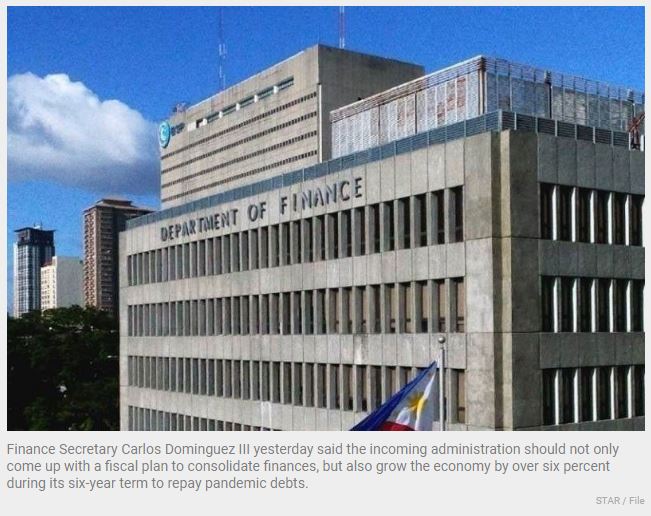Philippines: 6% annual growth needed to pay pandemic debt — DOF
MANILA, Philippines — The Philippine economy has to expand by more than six percent every year until 2028 to ensure that the government can repay the debts piled up by the Duterte administration during the COVID pandemic.
Finance Secretary Carlos Dominguez III yesterday said the incoming administration should not only come up with a fiscal plan to consolidate finances, but also grow the economy by over six percent during its six-year term to repay pandemic debts.
“We have to really grow out of the debt – in other words, expand our economy by better than six percent per year over the next five or six years,” Dominguez said in a TV interview.
“The biggest challenge for the next administration is really to grow out of the debt we incurred during the pandemic, which was natural because our revenues went down due to the lockdowns and we had increased expenditures. We had to borrow more money,” he said.
From P7.73 trillion in 2019, the debt pile ballooned by nearly 27 percent to P9.8 trillion in 2020, followed by a 20 percent increase to P11.73 trillion in 2021.
As of January this year, the government had borrowed P1.3 trillion from foreign lenders to improve health facilities and purchase vaccine doses. The bulk of the financing, at more than P559 billion, was raised by the Bureau of the Treasury through its bond issuances.
The government received financing from the Asian Development Bank amounting to P303.37 billion; the World Bank, P292.95 billion; the Asian Infrastructure Investment Bank, P66.01 billion; and from the Japan International Cooperation Agency, P47.56 billion; the French Development Agency, P28.96 billion, and from the Korea Eximbank, P10.15 billion.
The country’s debt-to-GDP ratio spiraled to a 16-year high of 60.5 percent in 2021, two years after it had dropped to a record-low of 39.6 percent in 2019. The global community observes a debt-to-GDP standard of 60 percent. Going beyond that level can alarm creditors about an economy’s capacity to pay.
The government expects the gross domestic product (GDP) to rise by seven to nine percent this year and by six to seven percent in 2023 and 2024. Last year, the GDP recovered by 5.7 percent on the back of economic reopening, somewhat offsetting the record worst decline of 9.6 percent in 2020.
“The next administration would have to design policies and stick to strict fiscal discipline to grow out of this debt problem,” Dominguez said.
Despite this, Dominguez said the economy could achieve such a feat of successive six percent growth, even in the face of uncertainties on when the pandemic will end. What the government should be looking out for, he warned, is the inflationary impact of Russia’s invasion of Ukraine.
“We are well on our way to recovery, except now we have this Ukraine crisis and that’s going to weigh a bit heavily on us,” the finance chief said.
In its latest forecast, the Bangko Sentral ng Pilipinas raised its inflation outlook to 4.3 percent for the year, anticipating that crude oil prices will average $102.23 per barrel due to the war in Ukraine.
Source: https://www.philstar.com/business/2022/04/22/2175823/6-annual-growth-needed-pay-pandemic-debt-dof


 English
English




